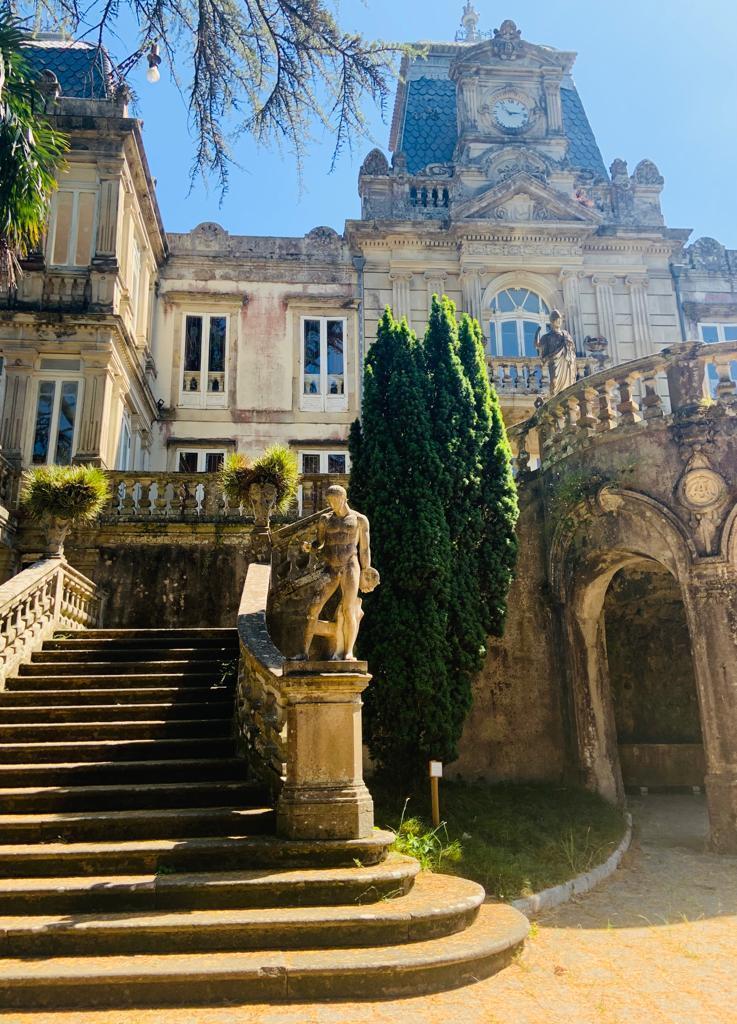Fortunes Marta Ortega buys a fabulous 16th-century country house in A Coruña for three million
Controversy The strategy of the Franco to not deliver the Pazo de Meirás
Properties El Pazo de Meirás: from Franco's summer home to Sánchez's possible summer getaway
Its silhouette is parallel to the first steps of the Portuguese road that cross the
parish of Santo André de Lourizán.
But for years no one has stopped to see its fountains, welcomes itself within its walls or is fascinated by its statues.
The Pazo de Lourizán is one of the 900 cataloged pazos
that exist in Galicia and, despite its historical importance, one of the most forgotten.
Located in Pontevedra, Herbalonga, it was the official home of President Eugenio Montero Ríos.
On the beaches that surround it, Alfonso XIII and other members of the Spanish high society of the 1930s spent the summer.
Now, on the eve of the 21st century,
this modernist-style palace has endured decades of neglect.
Dilapidated, neglected and admired only from a distance, it owes its decline to the indecisive bureaucracy that left its rooms unswept long before the democratic transition.
The Xunta for the Diputación and the Diputación for the Xunta
, the Pazo de Lourizán has survived thanks to its solid architecture, although it is dying due to the institutional paperwork that began its marathon in the 40s
.
It had to be other roles, those of a novel, that saved
this noble and ruined
mansion
in extremis .
One of the access stairs to Pazo de LourizánNoela Roibas
Fiction surpassed reality
"If the palace had been in
England or France, imagine how valued it would be
," the writer Lola Fernández Pazos claims to LOC.
Author of the novel
El Pazo de Lourizán
(Harper Collins, 2022), her book tells the story of a Galician industrial family that she decided to locate in this stately residence
built by the prestigious architect Jenaro de la Fuente.
"That family existed, but they didn't live there.
I just wanted to place them in a place at their height,"
she describes.
What she did not know was that the great sales success of her
debut work
was going to bring with it
the recovery of the palace of her story after decades of neglect.
A journalist by profession, Fernández Pazos studied the papers given to him
by the great-great-grandson of Eugenio Montero Ríos,
the Marquis of Alhucemas, Manuel Saiz de Vicuña.
Through an extensive study he was able to learn about the evolution of an ambitious project
that ended up being the site of the most powerful in Spain.
A close friend of the regent María Cristina, Montero Ríos was the promoter of this architectural creation oxygenated by
56 hectares of gardens with plants from all over the world:
from water lilies to camellias and eucalyptus.
That until today decorate and enliven the area.
The journalist Lola Fernández Pazos, author of the novel 'El Pazo de Lourizán'Noela Roibas
The history of the
Pazo de Lourizán dates back to the fifteenth century
, when that greened place
became the ideal location for farms
.
A dovecote remains almost intact from this period.
"Fountains from the 17th and 18th centuries are preserved",
says the author.
But without a doubt, the first turning point in the evolution of the pazo was in the 19th century, when the site was bought by
the Catalan merchant Buenaventura Marcó del Pont y Bori.
Some time later,
the first French influences were incorporated
into a country house whose style is far from other Galician stately homes.
presidential residence
In 1832, Eugenio Montero Ríos, an influential minister under Amadeo I, acquired the site and commissioned the construction of a family summer home there, where he lived until 1914.
The Galician politician later became president
of the Council of Ministers and the Senate during the Restoration.
At this time, he made a large part of the decisions and
held tense negotiations within the palace.
But, without a doubt, there is one that deeply marked Hispanism.
"It is where the loss of Cuba, the Philippines, Guam and Puerto Rico is assumed
. In Paris, Montero Ríos refuses to sign the loss of the colonies
and returns to Lourizán without assimilating it."
One of the 18th century fountains of the Pazo de LourizánNoela Roibas
There he received a message
from María Cristina explaining that the situation was irreversible.
It is 1898, but the history of Spain must continue.
Being Lourizán a small part of it.
"There are documented excursions of Alfonso XIII to the island of Tambo",
which once belonged to the territory of the pazo.
"On the beaches of the area
, rich in shellfish, he used to spend the summer the creamiest of society".
In 1943, "the daughter of Montero Ríos and Marchioness of Alhucemas, Avelina García-Prieto Montero-Ríos,
part with the Pazo de Lourizán in exchange for 220,000 pesetas".
It becomes the property of the Savings Bank, which sells it to the State.
One of the statues of the Pazo de LourizánNoela Roibas
That year, Francisco Franco
located
the first Forestry School there.
But the building, but not its exterior flora, was forgotten by the institutions.
On July 9, the Xunta reached an agreement with the Pontevedra Provincial Council.
20 million will be allocated to rehabilitate the palace
that still sings habaneras of abandonment.
Conforms to The Trust Project criteria
Know more

